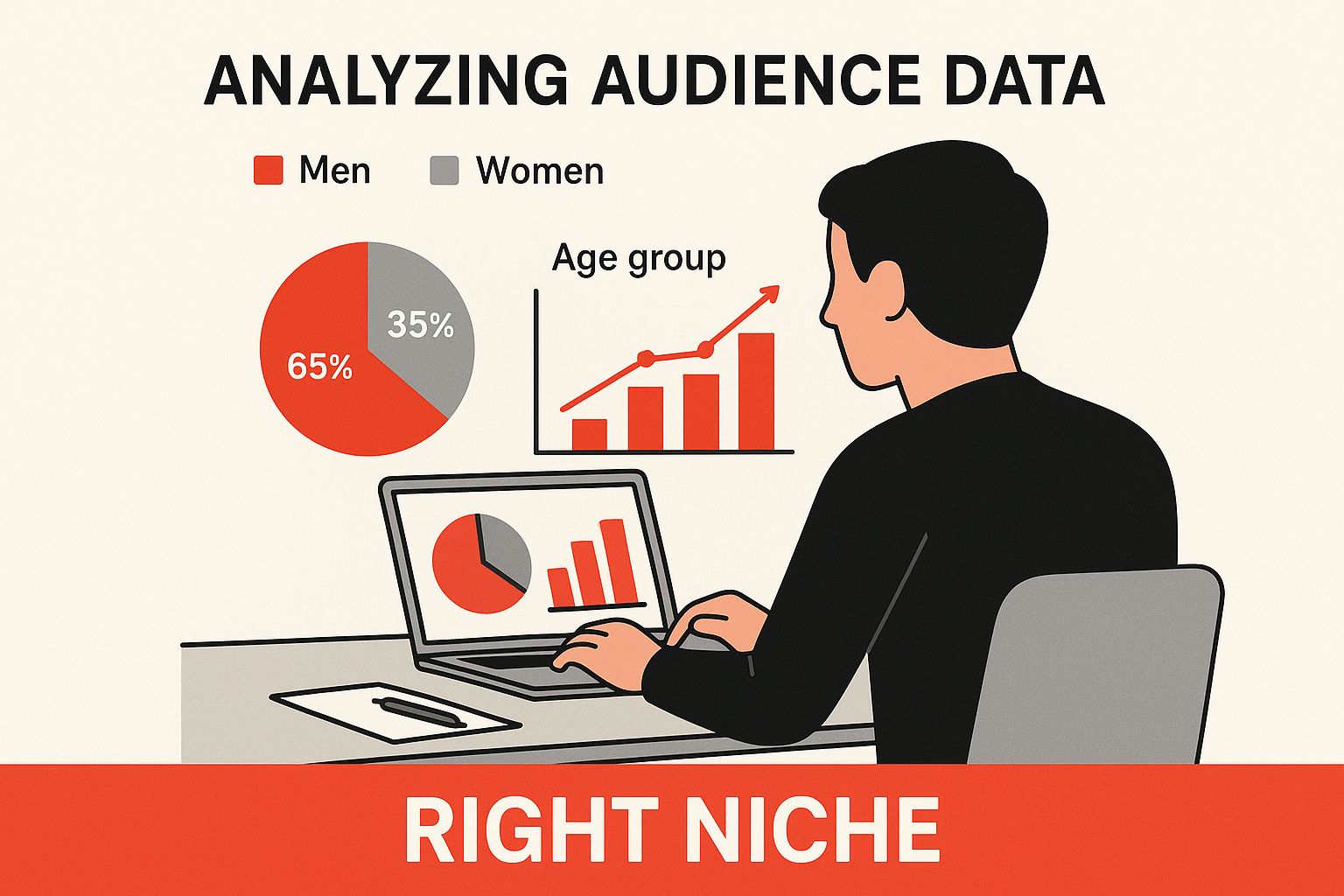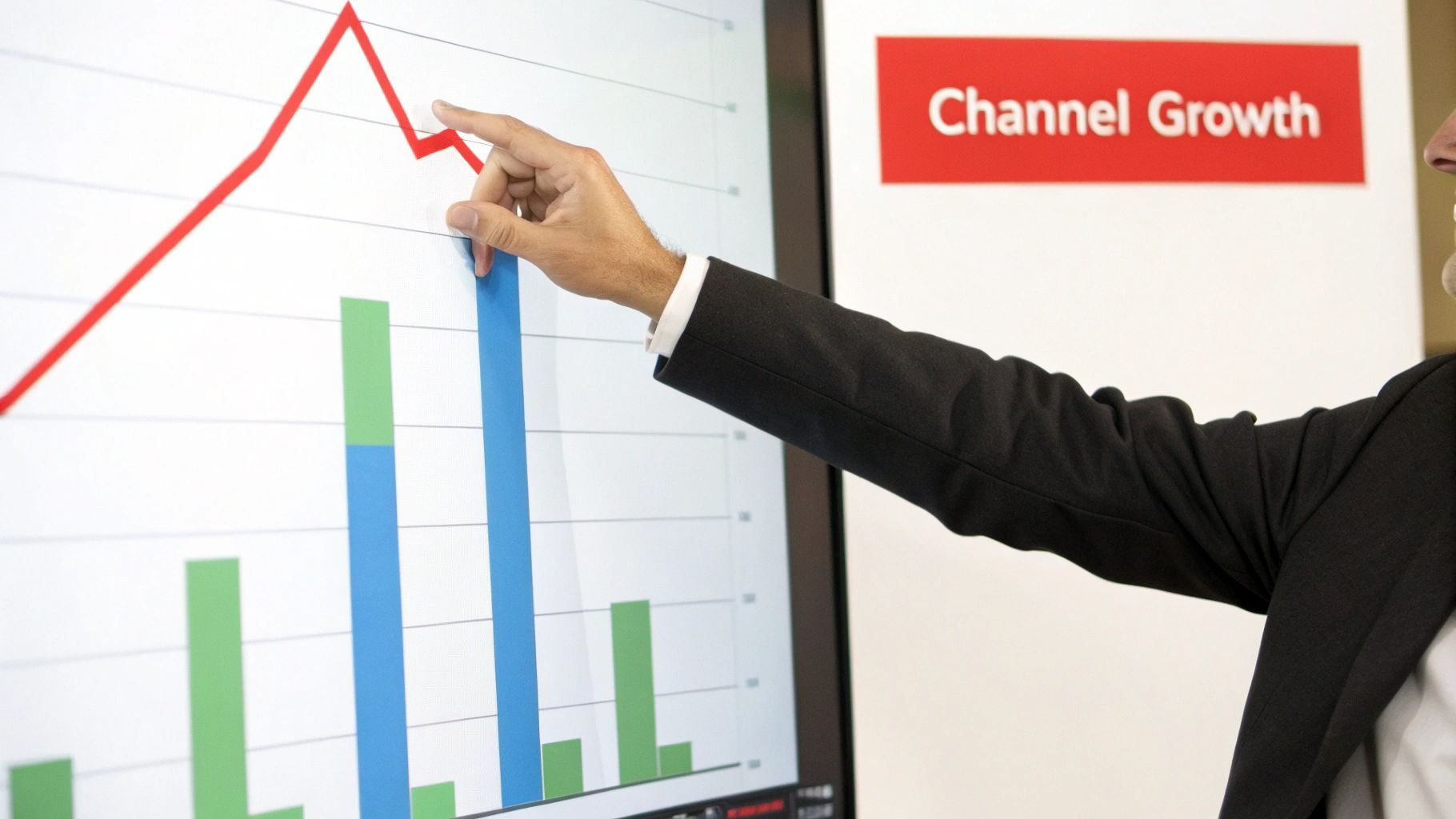A YouTube automation channel isn't about being a typical YouTuber. It's a business model where you build a system to pump out content consistently, often by outsourcing tasks like writing, voiceovers, and editing, or by using AI to do the heavy lifting. Think of it less like being a creator and more like building a scalable digital asset. The whole point is to run a channel without ever showing your face or getting bogged down in the daily production grind.
What a YouTube Automation Business Really Looks Like
Let's get one thing straight: a YouTube automation channel is not some magic button that prints money overnight. It’s a real business, and it requires you to think like an entrepreneur. Instead of being the star of the show, you're the producer pulling the strings behind the scenes, building a well-oiled content machine. Your job shifts from creator to manager.
The entire model is built on two pillars: delegation and systems. You won't be writing every script or editing every video. Instead, you'll create a repeatable process and then hire freelancers or find the right tools to run that process for you. This is the secret to the kind of consistent output that the YouTube algorithm loves.
You're the Producer, Not the Talent
The goal here is to decouple your time from the content creation itself. While your "automated" system handles the day-to-day work, you get to focus on the big-picture strategy that actually grows the channel.
So, what does that actually look like? You’ll be busy with:
- Finding Your Niche: Pinpointing a profitable content area that has staying power.
- Mapping Out Content: Planning video topics, keeping an eye on competitors, and jumping on trends.
- Building Your Team: Hiring writers, editors, and voice actors, or choosing the best AI tools for each job.
- Maintaining Quality: Making sure every single video meets your standards before it goes public.
- Analyzing Performance: Diving into the data to see what’s working and what isn’t, so you can make smarter content decisions.
Here’s a good way to think about it: You're the architect designing the blueprint for a skyscraper. Your automated system is the construction crew building it, floor by floor. Your vision is what guides the project, but you aren't laying every single brick yourself.
How AI and Outsourcing Fit In
The world of YouTube automation is changing fast. Today's channels are leaning heavily on AI, not just for simple tasks but as a core part of the creative process—from writing scripts and editing videos to even generating YouTube Shorts. AI-powered data tools are also becoming essential for smart competitor analysis and spotting the next big trend.
But even with all this tech, you can't just set it and forget it. YouTube has gotten much stricter about cracking down on low-effort, spammy content. The human touch—your unique creativity and strategic direction—is still the most important ingredient for long-term success. You can learn more about how creators are using AI to scale their channels on thunderbit.com and stay ahead of the curve.
Find a Niche You Can Actually Own
Let's get one thing straight: picking your niche is the most critical decision you'll make for your YouTube automation channel. It's the foundation of everything. Get this right, and you’re building on solid ground. Get it wrong, and you're essentially trying to build a skyscraper in a swamp.
Forget about broad, oversaturated categories like "fitness" or "finance." Those are digital battlegrounds where new channels go to die. Your mission is to find a specific, underserved sub-niche that you can completely own.
Think of it this way. You wouldn't open a general sporting goods store to compete with Walmart. Instead, you'd open a specialty shop that only sells high-performance gear for trail runners. You’d attract a smaller, more dedicated crowd that trusts your expertise and is ready to buy. That’s the exact mindset you need here.
Moving From Broad To Specific
The secret is to drill down. "History" is a massive, unwieldy topic. But what about "untold stories of espionage in the Cold War"? Now that is a niche. "Cooking" is too generic, but "30-minute vegan meal prep for busy professionals" speaks directly to a specific person with a specific need.
This is where you, the channel owner, need to put on your strategist hat. Fire up Google Trends and see what people are searching for over time. Go to YouTube, start typing your broad idea into the search bar, and pay close attention to the auto-suggestions. Those are real-time clues to what viewers are desperate to find.
This is the strategic work that separates the channels that succeed from the ones that fade away.

Analyzing what people want and where the content gaps are is non-negotiable. Don't even think about production until you’ve nailed this.
Validating Your Niche Idea
Once you've got a few promising ideas simmering, it's time to put them to the test. A truly solid niche has to check three crucial boxes:
- Audience Demand: Are people actually looking for this? A passionate audience is a hungry audience. Use keyword research tools to see if there's real search volume behind your idea.
- Monetization Potential: How are you going to get paid? Some niches are just more lucrative than others. Look for topics with high CPM (cost per mille) rates, obvious affiliate marketing opportunities, or the potential to sell your own digital products down the line.
- Content Depth: Can you realistically come up with 50-100 video ideas for this topic without scraping the bottom of the barrel? If the answer is no, you have a video topic, not a channel niche.
To help you think this through, I've put together a simple framework. Use this table to score your ideas and see which one has the best shot at success.
Niche Potential Analysis Framework
| Evaluation Criteria | High Potential Example (e.g., 'Historical Mysteries') | Low Potential Example (e.g., 'Funny Cat Videos') | Your Niche Idea Score (1-5) |
|---|---|---|---|
| Audience Passion | Very high; viewers love deep dives and theories. | High, but fleeting and not community-driven. | |
| CPM Rates | Medium to High; attracts advertisers in education/documentary. | Very Low; mass appeal but low ad value. | |
| Affiliate Potential | High; books, documentaries, genealogy services. | Very Low; difficult to sell related products. | |
| Content Depth | Nearly infinite; endless historical events and figures. | Limited; you'll run out of original ideas quickly. | |
| Competition Level | Moderate; a few big players but space for unique angles. | Extremely High; saturated with millions of videos. |
This isn't about finding a "perfect" score, but about being realistic. A lower score in one area, like competition, can be fine if you have a high score in audience passion and a unique angle.
The best niches often feel a little too specific at first. Don’t be afraid to niche down until it feels slightly uncomfortable. That’s usually the sweet spot where you find a loyal audience that’s been waiting for someone to make content just for them.
Ultimately, the niche you choose defines your channel's ceiling for growth and income. A well-chosen niche is like a launchpad, making everything that comes after—from getting views to making money—infinitely easier. For more ideas to get you started, check out our guide on the most profitable YouTube automation niches.
Building Your Content Production Machine

Alright, you've locked in a niche that has real potential. Now comes the fun part: building the engine that will actually power your YouTube automation channel. Think of this as your content assembly line—a repeatable system you can count on for a steady flow of high-quality videos.
If you get this system right, you can scale your channel without burning yourself out. The key is to break the process down into four distinct stages. At each step, you'll need to decide whether to use an AI tool, hire a freelancer, or maybe use a mix of both to hit your budget and quality goals. This isn't just about making a video; it's about engineering a workflow that works for you.
This content pipeline is the backbone of your whole operation. It’s what keeps every video consistent in its style, feel, and voice.
Scriptwriting and Research
The script is the blueprint. A weak script will always lead to a weak video, no matter how fancy your editing is. You’ve basically got two paths to go down here: human writers or AI generators.
- Human Scriptwriters: You can find thousands of talented writers on platforms like Upwork or Fiverr. A good writer can inject real personality, do the heavy lifting on research, and nail the specific tone your niche requires. Be prepared to invest anywhere from $25 to over $100 per script, depending on their experience and how deep the topic is.
- AI Scripting Tools: Tools like Jasper, or even just well-crafted prompts in ChatGPT, can spit out a script in minutes. They're incredibly fast and cost-effective, but you'll almost always need to give the output a human review. It’s on you to fact-check and smooth out any robotic phrasing to make it sound natural.
For real efficiency, you can also explore more advanced techniques, like leveraging AI tools like ChatGPT for scriptwriting with speech-to-text.
Voiceover and Audio
Audio quality is a deal-breaker. A robotic, tinny, or unclear voiceover is one of the fastest ways to get viewers to click away. Don't let your audio be the weak link.
The choice is pretty straightforward: AI-generated voices or human voice actors. AI voices from services like Murf.ai have gotten shockingly realistic and are great for channels that need a consistent, neutral delivery. They're quick, affordable, and usually part of a monthly subscription.
On the other hand, a human voice actor, found on the same freelance sites, brings an emotional range and nuance that AI just can't match yet. They typically charge more, often priced by the word or by the minute of finished audio.
Video Editing and Visuals
This is where most of the hours get sunk. The editor's job is to weave the script, voiceover, and all the visual assets—stock clips, animations, text overlays—into a story that keeps people watching.
Hiring a freelance video editor will give you the most polished, custom-looking result, but it's also the priciest option. As an alternative, a new wave of AI video editors is popping up. These tools can automatically sync visuals to your script, which can save you a massive amount of time. You can learn more about this by reading our deep dive into https://monetizedprofiles.com/blogs/monetization-on-social-media/automating-content-creation.
Pro Tip: Create a detailed Standard Operating Procedure (SOP) for your editor. This is a simple document that spells out everything from your brand's fonts and colors to the pacing and style of transitions you prefer. An SOP is your quality control, ensuring every video looks and feels the same, no matter who is editing it.
Thumbnails and Packaging
Think of your thumbnail as your video's billboard on a busy highway. Its one and only job is to get someone to click. A killer thumbnail paired with a magnetic title is the one-two punch for a killer click-through rate (CTR).
You can definitely get by with templates from tools like Canva, but hiring a dedicated thumbnail designer is one of the smartest investments you can make early on. A good designer knows the visual psychology of what makes people click. They'll create eye-popping, custom artwork that makes your videos jump out in a sea of content.
Seriously, this is one area where you really don't want to cut corners.
How to Optimize and Scale for Growth
Once your content machine is up and running, you’ve cracked the code on quantity. Now it's time to shift your focus to quality and, most importantly, reach. A truly successful YouTube automation channel doesn't just churn out videos; it strategically optimizes every single one to get discovered and spark serious growth.
The real beauty of automation is the time it gives you back. While your system is busy creating the content, you get to focus on the high-impact stuff that actually moves the needle. This is where you evolve from a content producer into a growth strategist, zeroing in on things like SEO, audience retention, and building real channel authority.
Mastering YouTube SEO and Discoverability
Let's be clear: YouTube is a massive search engine, second only to Google. If you're not thinking about Search Engine Optimization (SEO), you’re basically making your videos invisible to thousands of potential viewers. Your first move should be to get comfortable with tools like TubeBuddy and VidIQ.
Think of these tools as your secret weapon for understanding the YouTube algorithm. They let you:
- Find High-Demand Keywords: Uncover the exact phrases your target audience is typing into the search bar. This ensures you're making videos people are already looking for.
- Analyze Competitor Tags: Peek behind the curtain and see the specific keywords and tags that are sending traffic to the top videos in your niche.
- Track Keyword Rankings: Keep an eye on how your videos perform in search results, so you can tweak your strategy and climb the ranks.
This data-first approach takes the guesswork out of the equation. You stop hoping for a lucky break and start engineering your videos to be found.
The Power of Thumbnails and Click-Through Rate
Your thumbnail is the single most important piece of marketing you'll create for your video. Period. It’s your billboard on a very crowded digital street, fighting for eyeballs. A killer thumbnail combined with a curiosity-piquing title is what makes someone click your video over the dozens of others right next to it.
A high click-through rate (CTR) sends a massive signal to the YouTube algorithm that your content is compelling. When more people click, YouTube takes notice and starts showing your video to an even wider audience.
You absolutely have to A/B test your thumbnails. It's not optional. Make two versions for a new video, see which one gets more clicks in the first 24 hours, and then go with the winner. A tiny 1-2% bump in CTR can explode your view count over the long run.
Building Channel Authority and Watch Time
Optimizing individual videos is one thing, but you also need a channel-wide strategy. The goal is to create an experience that keeps people watching video after video on your channel, not clicking away.
A simple yet powerful way to do this is by organizing your videos into playlists based on your core topics or "content pillars." For instance, a channel about personal finance could have playlists for "Investing for Beginners," "Saving and Budgeting," and "Credit Score Hacks."
This not only makes your channel way easier for viewers to browse, but it also skyrockets your session watch time as they fall down a rabbit hole of your content. As you grow, staying on top of emerging concepts like Generative Engine Optimisation strategies can give you a real edge in getting discovered.
Don't Just Rely on YouTube Ads for Your Income

Putting all your eggs in the YouTube AdSense basket is a rookie mistake. It’s like building a house with only one support beam—sure, it might stand for a bit, but you're one algorithm change away from disaster. The real money and stability come from building several different income streams that work for you 24/7.
For most automated channels, the quickest and most powerful way to start earning is through affiliate marketing. It just makes sense. You're already creating content that targets people with specific interests, so all you have to do is point them toward products and services they’ll genuinely love.
The best part? You don't need a huge subscriber count to get going. You can start making money from your very first video by placing strategic affiliate links in your description.
Get Paid Recommending Products You Trust
The secret to making affiliate marketing work is relevance. If your channel breaks down historical battles, link to your favorite history books on Amazon. If you're teaching people how to use software, partner with those tech companies directly or through a network like ClickBank.
The trick is to make it feel natural, not spammy. Don't just dump a wall of links in your description. Mention a specific tool or resource you used in the video, then casually tell viewers they can find the link below if they want to check it out.
For a deeper dive into making this work, this guide to YouTube affiliate marketing success is a great resource for building out your strategy.
Build a Real Business by Selling Your Own Products
Affiliate income is a great start, but the real game-changer is creating and selling your own digital products. This is where you get the best profit margins and turn your channel from a simple content machine into a legitimate business.
The ideas are endless and should be a natural extension of your content.
- Got a finance channel? You could sell a killer budgeting spreadsheet or a PDF guide on investing for beginners.
- Running a history channel? Design and sell high-resolution digital maps or timelines of the events you cover.
- Have a meditation channel? Package and sell your own guided audio meditations or a mindfulness e-book.
These products offer a real solution to a problem your audience has, which makes them an easy sell to people who already know, like, and trust you.
You're tapping into a massive ecosystem. With over 2.5 billion active users and revenue topping $50 billion a year, YouTube has a staggering amount of money flowing through it. Creators who think beyond ads are the ones capturing a bigger piece of that pie.
In the end, having multiple ways to make money is what separates a fun hobby from a sustainable online business. Start exploring these top YouTube monetization alternatives to build a channel that's not just popular, but also profitable and resilient.
Got Questions About YouTube Automation?
Jumping into YouTube automation for the first time brings up a ton of questions. That’s completely normal. Getting straight answers is the best way to sidestep the usual mistakes that catch new creators off guard. Let's dig into some of the most common ones I hear.
What’s the Real Startup Cost?
This is usually the first thing people ask, and the honest answer is: it depends. Your budget can be anywhere from a few hundred dollars to several thousand.
If you’re taking a DIY approach, you’ll be leaning heavily on AI tools for things like scripts, voiceovers, and even video editing. In that case, you might only spend $200-$500 on initial software subscriptions. This route saves you money but costs you more of your time.
The alternative is a more hands-off model where you outsource everything by hiring freelancers. A single video can run you anywhere from $100 to over $300. If you're serious about this, a solid starting budget to get a batch of 10-15 quality videos out the door is realistically in the $1,500 to $3,000 range. Think of it as an investment in a real business asset, not just a weekend project.
Will AI Get My Channel Demonetized?
This is a big one, and it's a valid concern. The short answer is no, using AI itself is not against YouTube's rules. What is against the rules is pumping out low-effort, repetitive, and spammy content. The platform cares about quality and originality, not what tools you used to get there.
The thing to remember is this: YouTube doesn’t punish you for the tool, it punishes you for the output. As long as your AI-assisted videos are genuinely engaging and provide real value to your audience, you're playing by the rules. I always recommend having a human do a final quality check to make sure it feels right and adds a unique touch.
How Long Until I Actually Make Money?
You have to be patient. This isn't an overnight thing. For a brand-new channel, it typically takes 6 to 12 months to hit the YouTube Partner Program requirements: 1,000 subscribers and 4,000 watch hours.
Of course, your timeline depends on your niche, how good your videos are, and how consistently you post. A viral hit can obviously speed things up, but you should be prepared to play the long game. While you can start earning with things like affiliate links much sooner, significant income only comes after you've built a loyal audience.
What are the Biggest Mistakes People Make at the Start?
I see so many new creators stumble over the same roadblocks. Knowing what they are ahead of time gives you a huge advantage.
- Jumping into a crowded niche: If you pick a huge, competitive topic like "health" or "finance" without a unique spin, you'll just get lost in the noise.
- Choosing quantity over quality: Pushing out a ton of sloppy videos will do more harm than good.
- Expecting to get rich quick: This is a real business model, not a lottery ticket.
- Ignoring YouTube SEO: You can make the best video in the world, but if you don't optimize your titles, descriptions, and thumbnails, no one will ever find it.
- Quitting too early: Your first 20-30 videos are all about learning and collecting data. You have to stick with it long enough to see what works and adjust your strategy.
Ready to skip the long wait for monetization? At MonetizedProfiles, we provide YouTube accounts that are already approved for the Partner Program, letting you earn revenue from day one. Get your monetized channel today and fast-track your journey to success.









